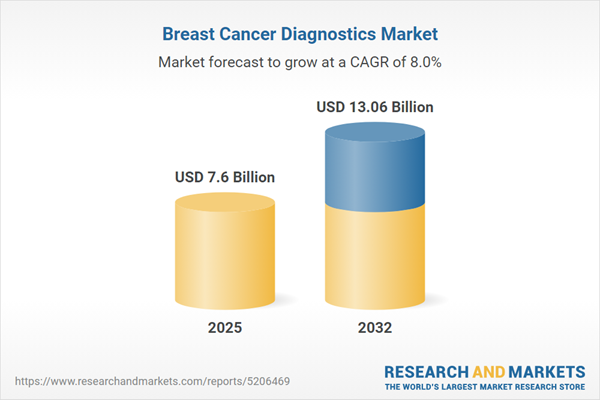Speak directly to the analyst to clarify any post sales queries you may have.
The breast cancer diagnostics market is evolving quickly as technological advances and shifting regulations drive new opportunities and challenges for healthcare leaders. Senior executives are increasingly focused on innovation, operational agility, and value-driven partnerships to navigate rising demand and intensifying industry competition.
Market Snapshot: Breast Cancer Diagnostics Market
The global breast cancer diagnostics market is projected to grow from USD 7.04 billion in 2024 to USD 7.60 billion in 2025, reflecting a compound annual growth rate (CAGR) of 8.02%. This momentum is fueled by rapid adoption of early detection strategies and advancements in screening methods. Industry players are prioritizing personalized diagnostics to deliver improved patient outcomes while optimizing accuracy and workflow efficiency. Imaging and molecular tools are strengthening testing reliability, and the need for compliance-ready solutions is prompting organizations to expand partnerships and adapt service portfolios in line with regulatory and reimbursement requirements.
Scope & Segmentation
- Technology: Biopsy, histopathology, mammography, tomosynthesis, immunohistochemistry, ultrasound, and MRI remain integral to diagnostic workflows. Molecular diagnostics such as FISH, next-generation sequencing, and PCR enhance clinical decision-making for targeted therapies and robust patient stratification.
- Product: Laboratory consumables including reagents and assay kits support standard testing. Diagnostics depend on a range of instruments from biopsy devices to imaging systems and sequencers, while advanced software and managed services improve operational reliability and ensure protected data management.
- Biomarker: Diagnostic panels including BRCA, ER/PR, HER2, and Ki-67 enable segmentation by patient characteristics, improve therapeutic targeting, and facilitate adherence to best practice treatment pathways.
- Sample Type: Analysis of blood, serum, and tissue samples improves diagnostic reach and strengthens individualized patient profiling and ongoing research capabilities.
- End User: Cancer research organizations, diagnostic laboratories, healthcare providers, and specialty clinics employ solutions to address evolving clinical needs, maintain regulatory compliance, and ensure high-quality service provision.
- Geography: Across the Americas, Europe, Middle East, Africa, and Asia-Pacific, variations in local regulation, infrastructure, and access to healthcare resources shape technology adoption and operational strategies.
- Companies & Competitive Innovation: Leading firms such as F. Hoffmann-La Roche Ltd., GE HealthCare Technologies, Siemens Healthineers, Hologic, and Philips consistently adapt product lines to satisfy emerging clinical practices and regulatory mandates globally.
Key Takeaways for Senior Executives
- Digital transformation, including artificial intelligence integration, streamlines diagnostic workflows and fosters actionable, data-driven decision-making.
- Molecular diagnostics and sequencing technologies offer improved alignment between test results and individualized treatment options, directly supporting patient-centered care.
- Proactive regulatory management allows for efficient market access while reducing the complexity of compliance across diverse healthcare settings.
- Telemedicine adoption and cloud-based secure solutions enhance accessibility, ensuring diagnostic services reach both urban and rural patient populations.
- Strategic alliances with technology and manufacturing experts support the timely introduction of innovative diagnostics and uphold patient management consistency.
- Agile supply chain approaches provide the flexibility to respond to fluctuating healthcare demand and regulatory changes, maintaining operational resilience.
Tariff Impact: United States Supply Chain Shifts
With ongoing adjustments in U.S. tariff policy, organizations active in breast cancer diagnostics are reinforcing supply chain resilience. By diversifying supply sources, evaluating new manufacturing hubs, and updating compliance protocols, firms can sustain access to critical diagnostic solutions despite market disruptions.
Methodology & Data Sources
This report is founded on senior leadership interviews, sector-specific workshops, and directed industry surveys. All findings are verified against scientific literature, regulatory documentation, financial disclosures, and intellectual property data to maintain analytical rigor.
Why This Report Matters
- Assists leaders in benchmarking technology adoption and identifying operational improvements for a competitive edge in the breast cancer diagnostics market.
- Enables forward-looking planning around clinical protocol evolution, regulatory changes, and emerging diagnostic trends, supporting strategic clarity.
- Provides actionable guidance on market entry, segmentation, and reimbursement pathways to facilitate success in complex healthcare environments.
Conclusion
Executives prioritizing innovation, strategic collaboration, and adaptable supply chains will be best positioned to guide their organizations through sector change and achieve sustainable performance gains.
Additional Product Information:
- Purchase of this report includes 1 year online access with quarterly updates.
- This report can be updated on request. Please contact our Customer Experience team using the Ask a Question widget on our website.
Table of Contents
3. Executive Summary
4. Market Overview
7. Cumulative Impact of Artificial Intelligence 2025
Companies Mentioned
The companies profiled in this Breast Cancer Diagnostics market report include:- F. Hoffmann-La Roche Ltd.
- GE HealthCare Technologies GmbH
- Siemens Healthineers AG
- Hologic, Inc.
- Koninklijke Philips N.V.
- Thermo Fisher Scientific Inc.
- Abbott Laboratories
- QIAGEN N.V.
- Illumina, Inc.
- Becton, Dickinson and Company
Table Information
| Report Attribute | Details |
|---|---|
| No. of Pages | 189 |
| Published | November 2025 |
| Forecast Period | 2025 - 2032 |
| Estimated Market Value ( USD | $ 7.6 Billion |
| Forecasted Market Value ( USD | $ 13.06 Billion |
| Compound Annual Growth Rate | 8.0% |
| Regions Covered | Global |
| No. of Companies Mentioned | 11 |









